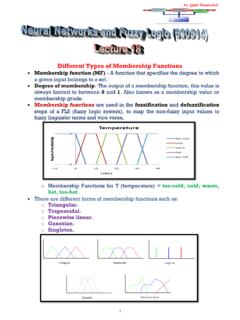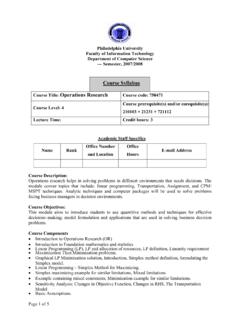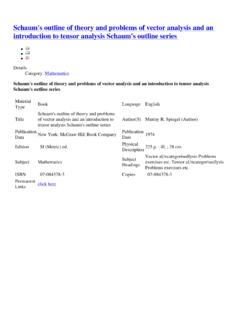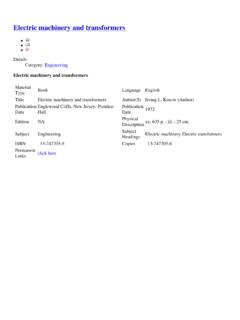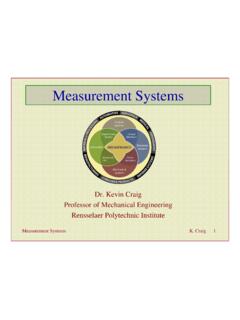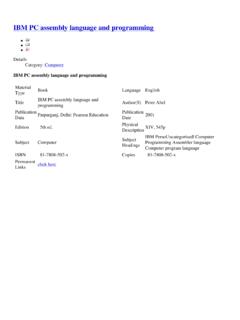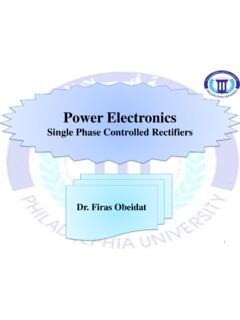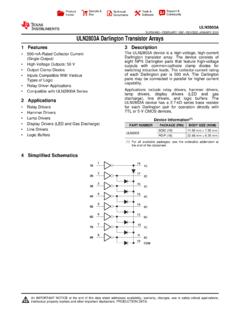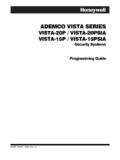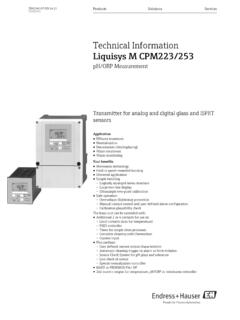Transcription of Power System Protection Part Power System Protection ...
1 Power System Protection Part 1 Tawfeeq 1 Power System Protection Lecture Notes Mohammed T. Lazim Alzuhairi Professor of Electrical and Electronics Engineering Electrical Engineering Department Philadelphia University, Jordan Power System Protection Part 1 Tawfeeq 2 Protection is the art or science of continuously monitoring the Power System , detecting the presence of a fault and initiating the correct tripping of the circuit breaker. The objectives of Power System Protection are to : Limit the extent and duration of service interruption whenever equipment failure, human error, or adverse natural events occur on any portion of the System Minimize damage to the System components involved in the failure and Prevention of human injury Protection engineering concerned with the design and operation of " Protection schemes".
2 Protection schemes are specialized control systems that monitor the Power System , detecting faults or abnormal conditions and then initiate correct action. In this course the Power System is considered as all the plant and equipment necessary to generate, transmit, distribute and utilize the electric Power . Power System Protection Introduction Power System Protection Part 1 Tawfeeq 3 The Construction of a Power System : Primary System Secondary systems in a Power System Protection Auto control for voltage, frequency, reactive Power compensation, Power flow, network configuration and stability Metering for billing, operational control and statistical data Local manual control (plant status, voltage level reactive Power support, network configuration) Remote manual control via communications links (SCADA) Plant condition monitoring and alarming (temperature, malfunction, maintenance need, operating duty)
3 Communications infrastructure Instrument transformers - current and voltage transformers Power System Protection Part 1 Tawfeeq 4 Protection against faults and abnormalities Types of Faults and Abnormalities Faults : The principal electrical System faults are short circuits and overloads. Short circuits may be caused in many ways, including failure of insulation due to excessive heat or moisture, mechanical damage to electrical distribution equipment, and failure of utilization equipment as a result of overloading or other abuse. Short circuits may occur between two-phase conductors, between all phases of a poly-phase System , or between one or more phase conductors and ground.
4 The short circuit may be solid (or bolted) or welded, in which case the short circuit is permanent and has relatively low impedance. The main types of faults in a Power System are: S h o r t-circuit faults (3Ф, 2 Ф, Ф g, 2 Ф g) O p e n-c i r c u i t f a u l t s ( o p e n c o n d u c t o r ) C o mp l e x f a u l t s ( i n t e r-c i r c u i t , b r o k e n c o n d u c t o r , c r o s s-c o u n t r y e t c ) I n t e r-t u r n f a u l t s i n w i n d i n g s Abnormalities: Real Power deficit - underfrequency Power swings Overload and excessive operating temperature Power frequency overvoltage or undervoltage Underexcitation of synchronous machines Overfluxing of Power transformers Asynchronous operation of synchronous machines Overfrequency Mechanical defects leaking oil, tap changer mechanism faults.
5 Power System Protection Part 1 Tawfeeq 5 Types of Faults Short circuit type faults (solidly earth fault) Power System Protection Part 1 Tawfeeq 6 Series (Open-circuit) type faults Faults in Windings Power System Protection Part 1 Tawfeeq 7 Typical Short-Circuit Type Distribution Single-Phase-Ground: 70 80 % Phase-Phase-Ground: 17 10 % Phase-Phase: 10 8 % Three-Phase: 3 2 % Causes of Short-Circuit Faults Insulation breakdown due to inherent weakness Lightning Birds and animals bridging insulators Dig-ups for underground cables Poles collapsing Conductors breaking Vehicle impact Wind borne debris Incorrect operation by personnel Etc Power System Protection Part 1 Tawfeeq 8 Effects of Short- Circuit Type Faults Large or very large currents can flow through parts of the network - thousands or tens of thousands of Amps can be involved These large currents can only be allowed to flow for a very short time otherwise equipment and generators would be damaged.
6 Most likely terminally - allowable short-circuit current flow duration could range from as short as 10 milliseconds up to say 3 seconds. Arcs, sparking and the heating effect of short-circuit currents can start fires involving non-electrical assets / property Very large mechanical forces can be caused by short -circuit currents which have potential to break or damage equipment Electric current can "escape" from the network conductors and flow through paths where they could create a hazard to people or livestock and cause damage to non-electrical assets/property Power System Protection Part 1 Tawfeeq 9 Performance Requirements of Protection System Discriminate between load (normal) and fault (abnormal)
7 Conditions Not be confused by non-damaging transient conditions Be selective - coordinate with other Protection systems Fast enough to prevent damage and hazards - but not too fast Have no "blind spots" unprotected zones High degree of reliability and availability Secure against incorrect operation (security) Should not restrict rating of primary plant and equipment Should be affordable Power System Protection Part 1 Tawfeeq 11 Basic Protection Scheme Components The isolation of faults and abnormalities requires the application of protective equipment that senses when an abnormal current flow exists and then removes the affected portion from the System .
8 The primary protective equipment components are shown in the following figure: PR Protection Relay CB Circuit Breaker Equip Protected Item CT Current Transformer VT Voltage Transformer DC Aux DC Auxiliary supply HMI Man-machine interface PCL Communications Link Tr CB trip coil The two primary protective equipment components used in the isolation of faults and abnormalities are circuit breakers, and protective relays. Power System Protection Part 1 Tawfeeq 11 1 CT or VT , 2- Relay 3- TC 4- CB 5- DC supply = Fault Alarm 3 Elements of a Protection System 1 5 A D P 2 4 Power System Protection Part 1 Tawfeeq 12 3 1 A D P 2 Relays are the logic elements which initiate the tripping and closing operations.
9 Elements of a Protection System 1 The function of transducers (usually CT and VT) is to provide current and voltage signals to the relays, to detect deviations of the parameters watched over. Power System Protection Part 1 Tawfeeq 13 3 1 5 A D P 2 4 Tripping Power , as well as Power required by the relays, is usually provided by the station battery because is safer than the ac faulted System . 3 Elements of a Protection System 1 2 4 Circuit breakers isolate the fault by interrupting the current. Power System Protection Part 1 Tawfeeq 14 What is the Purpose of the Relay? Power System Protection Dr.
10 Mohamad Tawfeeq Protective Relays What is a Relay? Device which receives a signal from the Power System and determines whether conditions are "normal" or "abnormal" (measuring function)- If an abnormal condition is present, relay signals circuit breaker to disconnect equipment that could be damaged (Switching or signaling function) "Relays" signal from System to circuit breaker. The purpose of the protective relaying systems is to isolate only the faulty component of Power System . Relaying equipments are classified into two groups: 1. Primary relaying equipment. 2. Back-up relaying equipment. Primary relaying is - the first line of defense for protecting the equipments.
